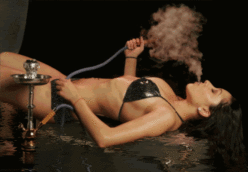(Permission granted by author) :
I was reading a book this week about various first hand personnal stories and views on Calcutta,India from the time it was first built by a private British citizen 200 plus years ago until the squallor of today.
One short chapter was written by Fanny Parkes in 1824 and she has a mention on hookahs. No copyright infrigements here as the editor of the book states that short portions can be used for reviews. looking online, I found many searches available for this “white english woman” who became Indian in culture after many years.
http://www.google.com/search?q=fanny+parkes&rls=com.microsoft:en-us&ie=UTF-8&oe=UTF-8&startIndex=&startPage=1
The illustrations she drew of her travels were amazing.
Quote : author Fanny Parkes
“Begums,Thugs, and White Mughals” 1824 (“Thug” originally a Bengali word)
“To a person fresh from england, the number of servants attending at a table is remarkable. We had only a small party of eight to dinner yesterday, including ourselves;
three-and-twenty servants were in attendance! Each gentleman takes his own servants in number from one to six , and each lady her attendant or attendants ,as pleases her fancy.
The HUQQA was very commanly smoked,at that time in Calcutta : before dinner was finished , each man’s pipe was behind his chair.The tobacco was generally so well prepared that the odour was not unpleasant, unless by chance you sat next to a man from the “mofusill” {(suburbs) unlike American suburbs etc, those were what would be called”the sticks” where “hillbillies “of India! lived}, when the fume of the spices used by the up -country HUQQA “Bardars” (Huqqa Bardar is the private servant tending each hookah) preparring the tobacco ,rendered it oppresive and disagreeable.”
Images by Fanny Parkes :
note :
shisha was preparred by the hookah bardar using dry leaves of tobacco, rinsing and sometimes soaking with water, squeezing out most of the water leaving the tobacco clump moist, spreading out the clump and adding the “Sahib”‘s (Master’s)favourite spices or tastes and adding honey in rare cases since the tobacco was wet and required no addition of gycerine like we use.
Wouldn’t be suprised if there are many accounts of hookah use from the 17th or 18th century first hand.
I remember around 4 pages of a Rudyard Kipling short story where he wrote in long and great detail about the preparrations, the hookah bardar made, and how people were smoking. I think the Sultan in the group if I remember ground up a large pearl and it was added to his shisha!!! Look online , it could get interesting.
“If you don’t know where you came from, you won’t know where you are going to”.
Hookah 1 Shisha Bubbly Man of many Faces

